Plumbing, Wiring & Hot Water System Design for Strathfield Development
VerifiedAdded on 2023/06/15
|6
|1375
|61
Project
AI Summary
This project outlines the design of plumbing, wiring, and hot water systems for a commercial and residential development in Strathfield, NSW. The plumbing system employs a vented single-stack system, ensuring efficient waste discharge and preventing foul air accumulation. The report also details a viable hybrid hot water system, integrating solar and gas heating for improved efficiency and reduced carbon footprint. Furthermore, it discusses the choice between individual and building-wide air conditioning systems, recommending a centralized system for the multi-story commercial building. The document includes stack work diagrams and considerations for system improvements like pipe insulation and demand-controlled systems. For more solved assignments and past papers, visit Desklib.
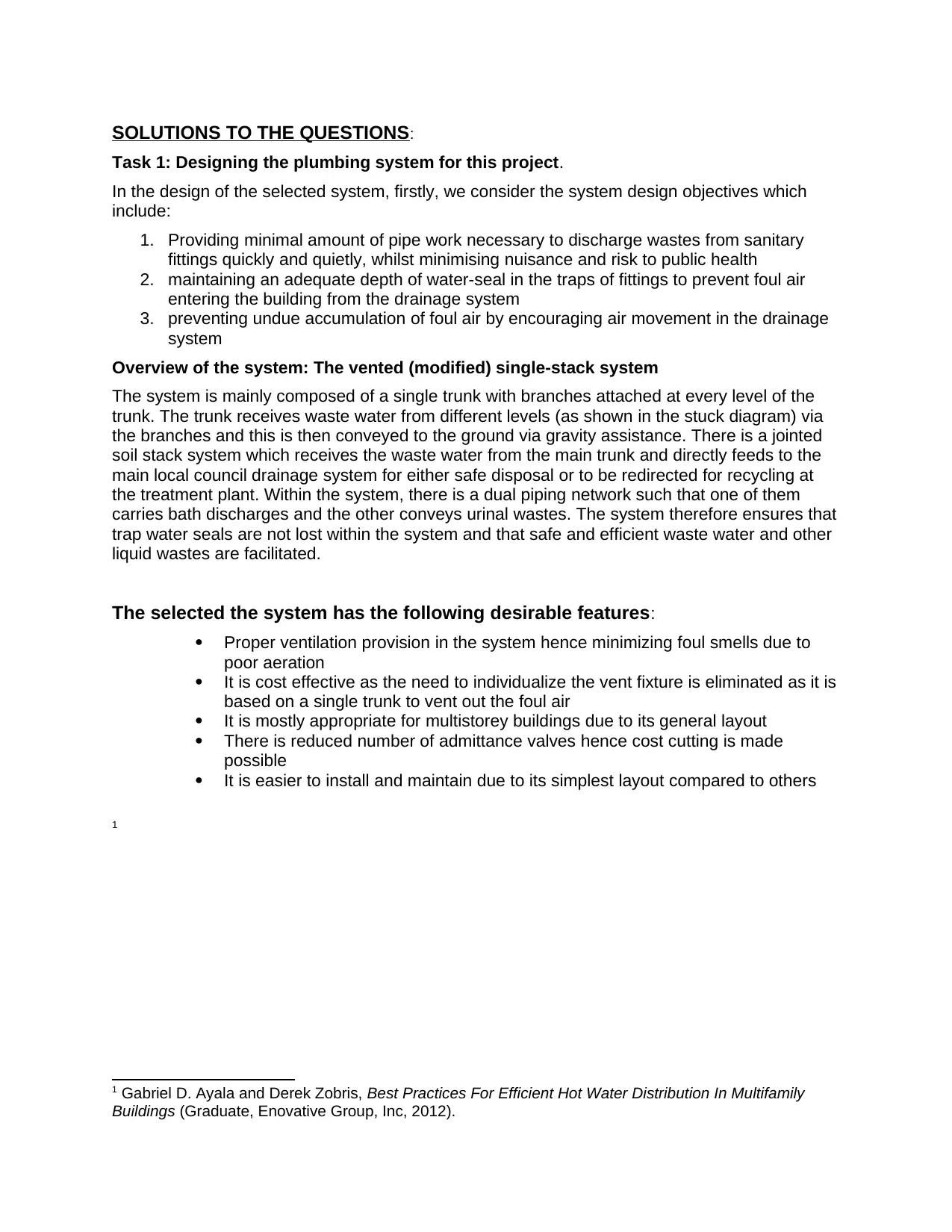
SOLUTIONS TO THE QUESTIONS:
Task 1: Designing the plumbing system for this project.
In the design of the selected system, firstly, we consider the system design objectives which
include:
1. Providing minimal amount of pipe work necessary to discharge wastes from sanitary
fittings quickly and quietly, whilst minimising nuisance and risk to public health
2. maintaining an adequate depth of water-seal in the traps of fittings to prevent foul air
entering the building from the drainage system
3. preventing undue accumulation of foul air by encouraging air movement in the drainage
system
Overview of the system: The vented (modified) single-stack system
The system is mainly composed of a single trunk with branches attached at every level of the
trunk. The trunk receives waste water from different levels (as shown in the stuck diagram) via
the branches and this is then conveyed to the ground via gravity assistance. There is a jointed
soil stack system which receives the waste water from the main trunk and directly feeds to the
main local council drainage system for either safe disposal or to be redirected for recycling at
the treatment plant. Within the system, there is a dual piping network such that one of them
carries bath discharges and the other conveys urinal wastes. The system therefore ensures that
trap water seals are not lost within the system and that safe and efficient waste water and other
liquid wastes are facilitated.
The selected the system has the following desirable features:
Proper ventilation provision in the system hence minimizing foul smells due to
poor aeration
It is cost effective as the need to individualize the vent fixture is eliminated as it is
based on a single trunk to vent out the foul air
It is mostly appropriate for multistorey buildings due to its general layout
There is reduced number of admittance valves hence cost cutting is made
possible
It is easier to install and maintain due to its simplest layout compared to others
1
1 Gabriel D. Ayala and Derek Zobris, Best Practices For Efficient Hot Water Distribution In Multifamily
Buildings (Graduate, Enovative Group, Inc, 2012).
Task 1: Designing the plumbing system for this project.
In the design of the selected system, firstly, we consider the system design objectives which
include:
1. Providing minimal amount of pipe work necessary to discharge wastes from sanitary
fittings quickly and quietly, whilst minimising nuisance and risk to public health
2. maintaining an adequate depth of water-seal in the traps of fittings to prevent foul air
entering the building from the drainage system
3. preventing undue accumulation of foul air by encouraging air movement in the drainage
system
Overview of the system: The vented (modified) single-stack system
The system is mainly composed of a single trunk with branches attached at every level of the
trunk. The trunk receives waste water from different levels (as shown in the stuck diagram) via
the branches and this is then conveyed to the ground via gravity assistance. There is a jointed
soil stack system which receives the waste water from the main trunk and directly feeds to the
main local council drainage system for either safe disposal or to be redirected for recycling at
the treatment plant. Within the system, there is a dual piping network such that one of them
carries bath discharges and the other conveys urinal wastes. The system therefore ensures that
trap water seals are not lost within the system and that safe and efficient waste water and other
liquid wastes are facilitated.
The selected the system has the following desirable features:
Proper ventilation provision in the system hence minimizing foul smells due to
poor aeration
It is cost effective as the need to individualize the vent fixture is eliminated as it is
based on a single trunk to vent out the foul air
It is mostly appropriate for multistorey buildings due to its general layout
There is reduced number of admittance valves hence cost cutting is made
possible
It is easier to install and maintain due to its simplest layout compared to others
1
1 Gabriel D. Ayala and Derek Zobris, Best Practices For Efficient Hot Water Distribution In Multifamily
Buildings (Graduate, Enovative Group, Inc, 2012).
Paraphrase This Document
Need a fresh take? Get an instant paraphrase of this document with our AI Paraphraser
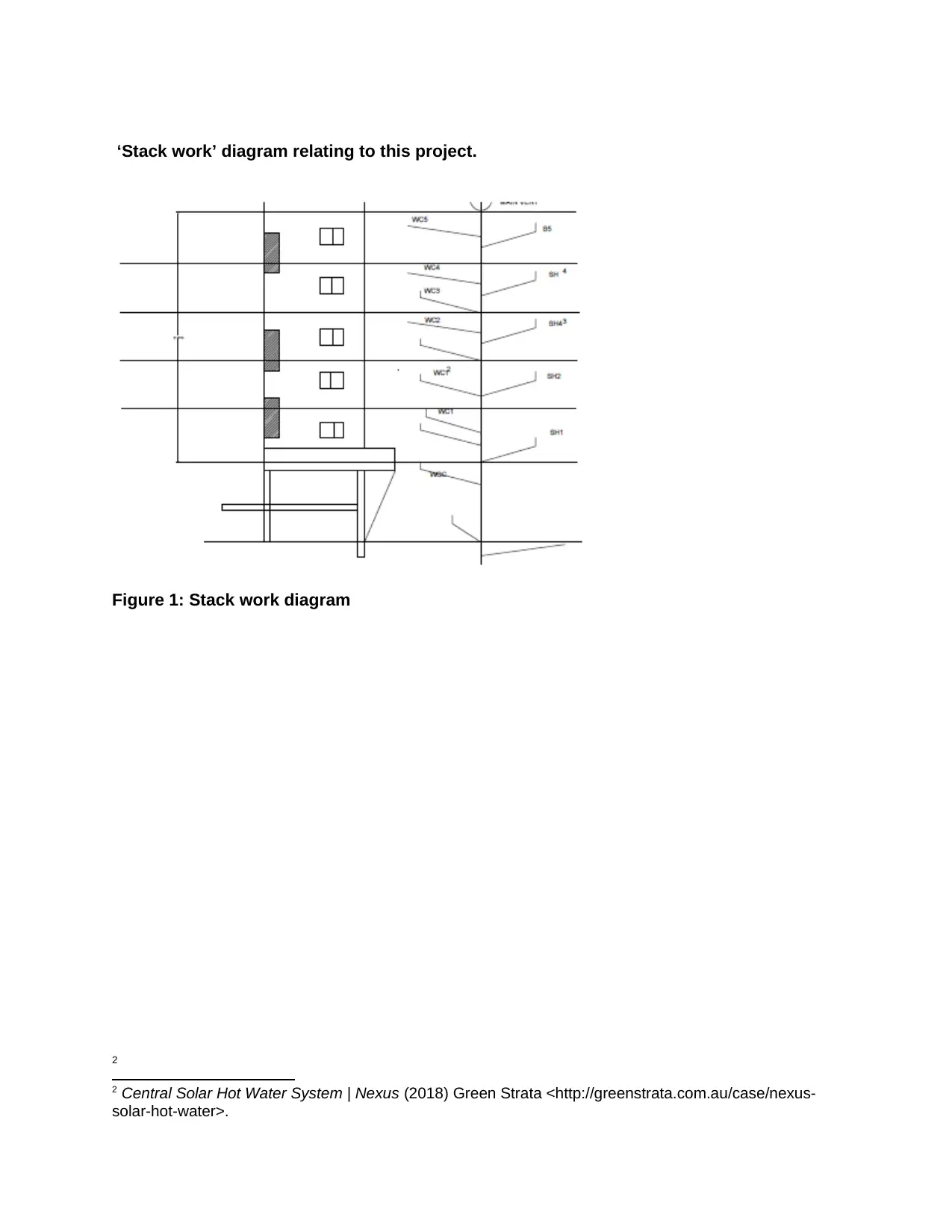
‘Stack work’ diagram relating to this project.
Figure 1: Stack work diagram
2
2 Central Solar Hot Water System | Nexus (2018) Green Strata <http://greenstrata.com.au/case/nexus-
solar-hot-water>.
Figure 1: Stack work diagram
2
2 Central Solar Hot Water System | Nexus (2018) Green Strata <http://greenstrata.com.au/case/nexus-
solar-hot-water>.
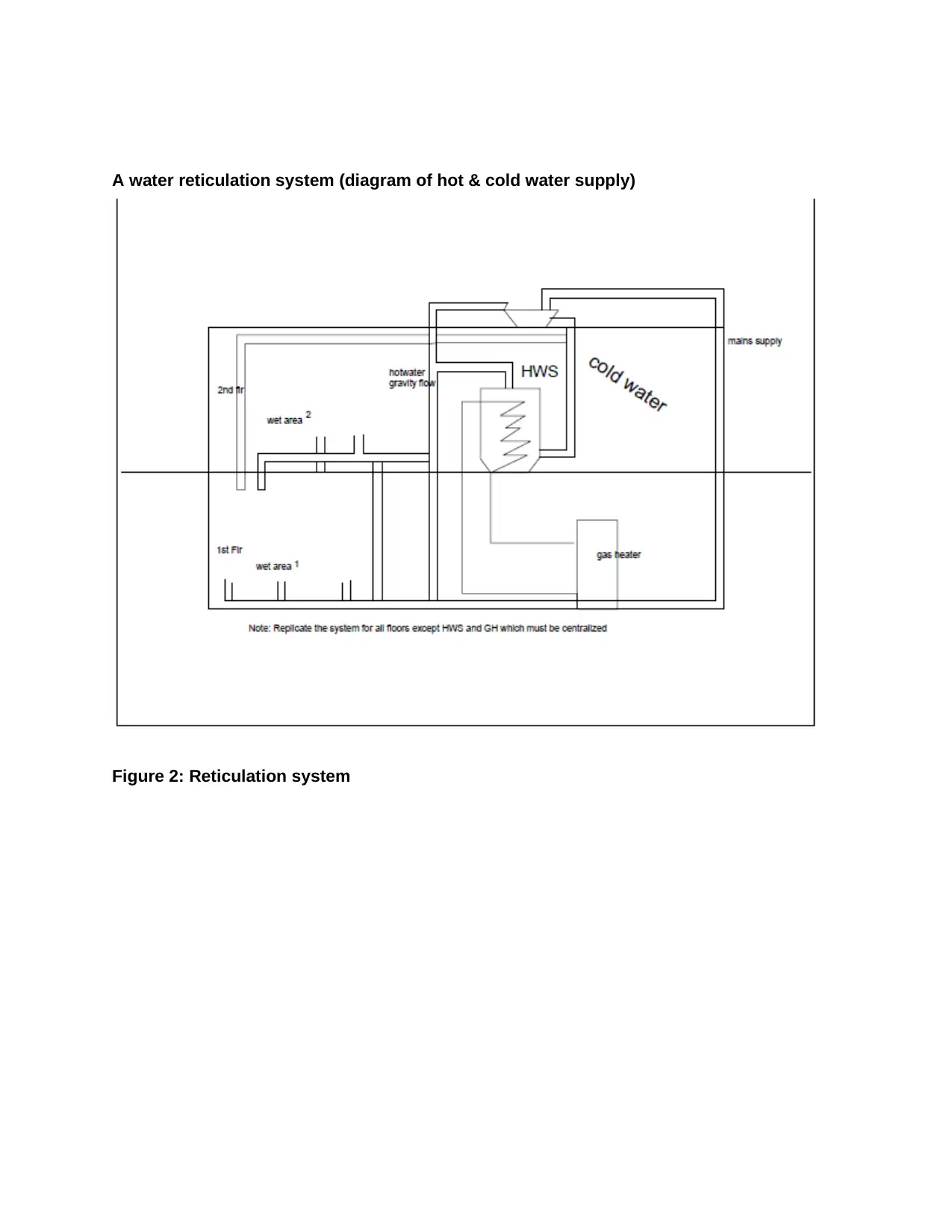
A water reticulation system (diagram of hot & cold water supply)
Figure 2: Reticulation system
Figure 2: Reticulation system
⊘ This is a preview!⊘
Do you want full access?
Subscribe today to unlock all pages.

Trusted by 1+ million students worldwide
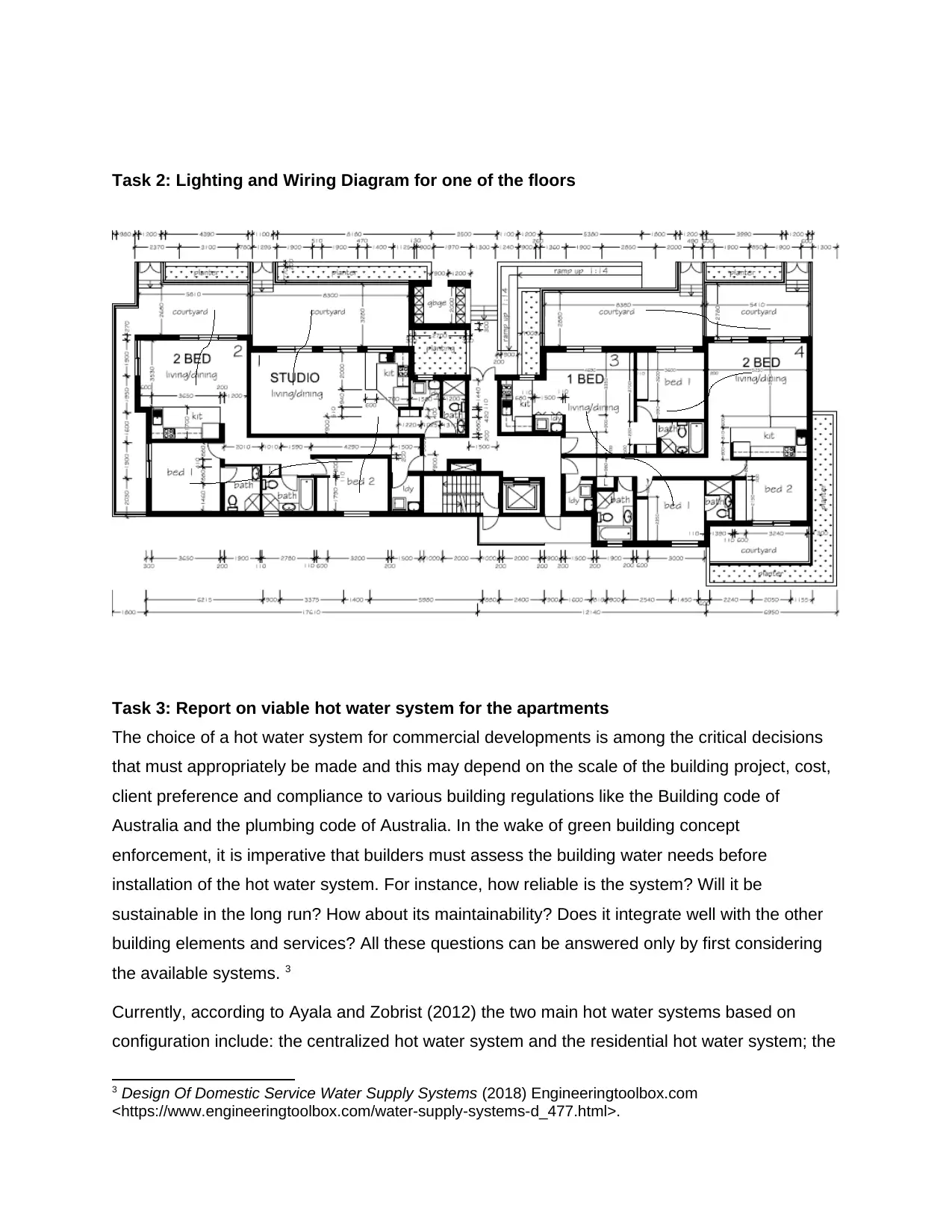
Task 2: Lighting and Wiring Diagram for one of the floors
Task 3: Report on viable hot water system for the apartments
The choice of a hot water system for commercial developments is among the critical decisions
that must appropriately be made and this may depend on the scale of the building project, cost,
client preference and compliance to various building regulations like the Building code of
Australia and the plumbing code of Australia. In the wake of green building concept
enforcement, it is imperative that builders must assess the building water needs before
installation of the hot water system. For instance, how reliable is the system? Will it be
sustainable in the long run? How about its maintainability? Does it integrate well with the other
building elements and services? All these questions can be answered only by first considering
the available systems. 3
Currently, according to Ayala and Zobrist (2012) the two main hot water systems based on
configuration include: the centralized hot water system and the residential hot water system; the
3 Design Of Domestic Service Water Supply Systems (2018) Engineeringtoolbox.com
<https://www.engineeringtoolbox.com/water-supply-systems-d_477.html>.
Task 3: Report on viable hot water system for the apartments
The choice of a hot water system for commercial developments is among the critical decisions
that must appropriately be made and this may depend on the scale of the building project, cost,
client preference and compliance to various building regulations like the Building code of
Australia and the plumbing code of Australia. In the wake of green building concept
enforcement, it is imperative that builders must assess the building water needs before
installation of the hot water system. For instance, how reliable is the system? Will it be
sustainable in the long run? How about its maintainability? Does it integrate well with the other
building elements and services? All these questions can be answered only by first considering
the available systems. 3
Currently, according to Ayala and Zobrist (2012) the two main hot water systems based on
configuration include: the centralized hot water system and the residential hot water system; the
3 Design Of Domestic Service Water Supply Systems (2018) Engineeringtoolbox.com
<https://www.engineeringtoolbox.com/water-supply-systems-d_477.html>.
Paraphrase This Document
Need a fresh take? Get an instant paraphrase of this document with our AI Paraphraser
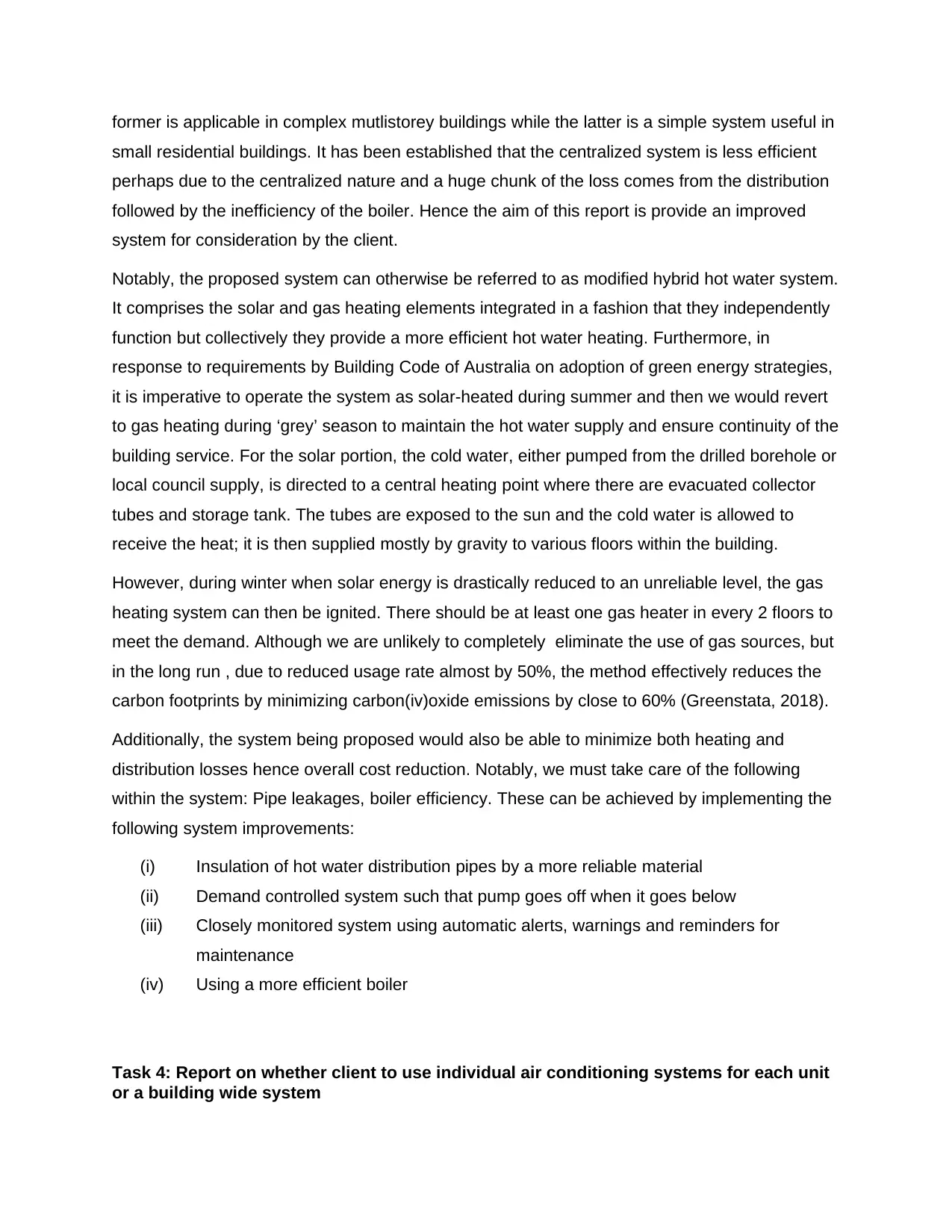
former is applicable in complex mutlistorey buildings while the latter is a simple system useful in
small residential buildings. It has been established that the centralized system is less efficient
perhaps due to the centralized nature and a huge chunk of the loss comes from the distribution
followed by the inefficiency of the boiler. Hence the aim of this report is provide an improved
system for consideration by the client.
Notably, the proposed system can otherwise be referred to as modified hybrid hot water system.
It comprises the solar and gas heating elements integrated in a fashion that they independently
function but collectively they provide a more efficient hot water heating. Furthermore, in
response to requirements by Building Code of Australia on adoption of green energy strategies,
it is imperative to operate the system as solar-heated during summer and then we would revert
to gas heating during ‘grey’ season to maintain the hot water supply and ensure continuity of the
building service. For the solar portion, the cold water, either pumped from the drilled borehole or
local council supply, is directed to a central heating point where there are evacuated collector
tubes and storage tank. The tubes are exposed to the sun and the cold water is allowed to
receive the heat; it is then supplied mostly by gravity to various floors within the building.
However, during winter when solar energy is drastically reduced to an unreliable level, the gas
heating system can then be ignited. There should be at least one gas heater in every 2 floors to
meet the demand. Although we are unlikely to completely eliminate the use of gas sources, but
in the long run , due to reduced usage rate almost by 50%, the method effectively reduces the
carbon footprints by minimizing carbon(iv)oxide emissions by close to 60% (Greenstata, 2018).
Additionally, the system being proposed would also be able to minimize both heating and
distribution losses hence overall cost reduction. Notably, we must take care of the following
within the system: Pipe leakages, boiler efficiency. These can be achieved by implementing the
following system improvements:
(i) Insulation of hot water distribution pipes by a more reliable material
(ii) Demand controlled system such that pump goes off when it goes below
(iii) Closely monitored system using automatic alerts, warnings and reminders for
maintenance
(iv) Using a more efficient boiler
Task 4: Report on whether client to use individual air conditioning systems for each unit
or a building wide system
small residential buildings. It has been established that the centralized system is less efficient
perhaps due to the centralized nature and a huge chunk of the loss comes from the distribution
followed by the inefficiency of the boiler. Hence the aim of this report is provide an improved
system for consideration by the client.
Notably, the proposed system can otherwise be referred to as modified hybrid hot water system.
It comprises the solar and gas heating elements integrated in a fashion that they independently
function but collectively they provide a more efficient hot water heating. Furthermore, in
response to requirements by Building Code of Australia on adoption of green energy strategies,
it is imperative to operate the system as solar-heated during summer and then we would revert
to gas heating during ‘grey’ season to maintain the hot water supply and ensure continuity of the
building service. For the solar portion, the cold water, either pumped from the drilled borehole or
local council supply, is directed to a central heating point where there are evacuated collector
tubes and storage tank. The tubes are exposed to the sun and the cold water is allowed to
receive the heat; it is then supplied mostly by gravity to various floors within the building.
However, during winter when solar energy is drastically reduced to an unreliable level, the gas
heating system can then be ignited. There should be at least one gas heater in every 2 floors to
meet the demand. Although we are unlikely to completely eliminate the use of gas sources, but
in the long run , due to reduced usage rate almost by 50%, the method effectively reduces the
carbon footprints by minimizing carbon(iv)oxide emissions by close to 60% (Greenstata, 2018).
Additionally, the system being proposed would also be able to minimize both heating and
distribution losses hence overall cost reduction. Notably, we must take care of the following
within the system: Pipe leakages, boiler efficiency. These can be achieved by implementing the
following system improvements:
(i) Insulation of hot water distribution pipes by a more reliable material
(ii) Demand controlled system such that pump goes off when it goes below
(iii) Closely monitored system using automatic alerts, warnings and reminders for
maintenance
(iv) Using a more efficient boiler
Task 4: Report on whether client to use individual air conditioning systems for each unit
or a building wide system
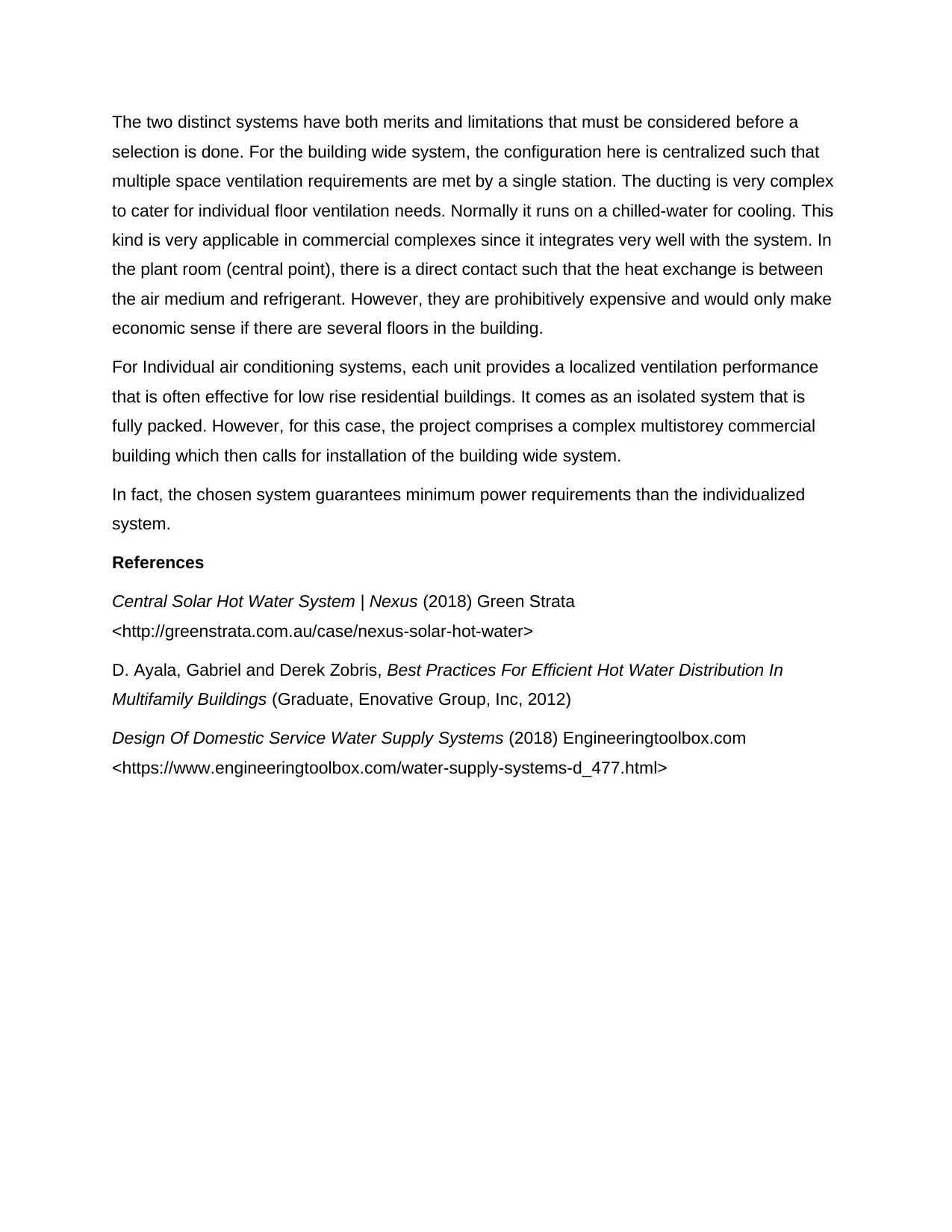
The two distinct systems have both merits and limitations that must be considered before a
selection is done. For the building wide system, the configuration here is centralized such that
multiple space ventilation requirements are met by a single station. The ducting is very complex
to cater for individual floor ventilation needs. Normally it runs on a chilled-water for cooling. This
kind is very applicable in commercial complexes since it integrates very well with the system. In
the plant room (central point), there is a direct contact such that the heat exchange is between
the air medium and refrigerant. However, they are prohibitively expensive and would only make
economic sense if there are several floors in the building.
For Individual air conditioning systems, each unit provides a localized ventilation performance
that is often effective for low rise residential buildings. It comes as an isolated system that is
fully packed. However, for this case, the project comprises a complex multistorey commercial
building which then calls for installation of the building wide system.
In fact, the chosen system guarantees minimum power requirements than the individualized
system.
References
Central Solar Hot Water System | Nexus (2018) Green Strata
<http://greenstrata.com.au/case/nexus-solar-hot-water>
D. Ayala, Gabriel and Derek Zobris, Best Practices For Efficient Hot Water Distribution In
Multifamily Buildings (Graduate, Enovative Group, Inc, 2012)
Design Of Domestic Service Water Supply Systems (2018) Engineeringtoolbox.com
<https://www.engineeringtoolbox.com/water-supply-systems-d_477.html>
selection is done. For the building wide system, the configuration here is centralized such that
multiple space ventilation requirements are met by a single station. The ducting is very complex
to cater for individual floor ventilation needs. Normally it runs on a chilled-water for cooling. This
kind is very applicable in commercial complexes since it integrates very well with the system. In
the plant room (central point), there is a direct contact such that the heat exchange is between
the air medium and refrigerant. However, they are prohibitively expensive and would only make
economic sense if there are several floors in the building.
For Individual air conditioning systems, each unit provides a localized ventilation performance
that is often effective for low rise residential buildings. It comes as an isolated system that is
fully packed. However, for this case, the project comprises a complex multistorey commercial
building which then calls for installation of the building wide system.
In fact, the chosen system guarantees minimum power requirements than the individualized
system.
References
Central Solar Hot Water System | Nexus (2018) Green Strata
<http://greenstrata.com.au/case/nexus-solar-hot-water>
D. Ayala, Gabriel and Derek Zobris, Best Practices For Efficient Hot Water Distribution In
Multifamily Buildings (Graduate, Enovative Group, Inc, 2012)
Design Of Domestic Service Water Supply Systems (2018) Engineeringtoolbox.com
<https://www.engineeringtoolbox.com/water-supply-systems-d_477.html>
⊘ This is a preview!⊘
Do you want full access?
Subscribe today to unlock all pages.

Trusted by 1+ million students worldwide
1 out of 6
Related Documents
Your All-in-One AI-Powered Toolkit for Academic Success.
+13062052269
info@desklib.com
Available 24*7 on WhatsApp / Email
![[object Object]](/_next/static/media/star-bottom.7253800d.svg)
Unlock your academic potential
Copyright © 2020–2025 A2Z Services. All Rights Reserved. Developed and managed by ZUCOL.


